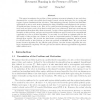Free Online Productivity Tools
i2Speak
i2Symbol
i2OCR
iTex2Img
iWeb2Print
iWeb2Shot
i2Type
iPdf2Split
iPdf2Merge
i2Bopomofo
i2Arabic
i2Style
i2Image
i2PDF
iLatex2Rtf
Sci2ools
WADS
2001
Springer
2001
Springer
Movement Planning in the Presence of Flows
This paper investigates the problem of time-optimum movement planning in two and three dimensions for a point robot which has bounded control velocity through a set of n polygonal regions of given translational ’¼éow velocities. This intriguing geometric problem has immediate applications to macro-scale motion planning for ships, submarines and airplanes in the presence of signi’¼ücant ’¼éows of water or air. Also, it is a central motion planning problem for many of the meso-scale and micro-scale robots that recently have been constructed, that have environments with signi’¼ücant ’¼éows that a’¼Ćect their movement. In spite of these applications, there is very little literature on this problem, and prior work provided neither an upper bound on its computational complexity nor even a decision algorithm. It can easily be seen that an optimum path for the 2D version of this problem can consist of at least an exponential number of distinct segments through ’¼éow regions. We provide the ’¼...
Algorithms | Computational Complexity | Decision Algorithm | Intriguing Geometric Problem | WADS 2001 |
Related Content
| Added | 30 Jul 2010 |
| Updated | 30 Jul 2010 |
| Type | Conference |
| Year | 2001 |
| Where | WADS |
| Authors | John H. Reif, Zheng Sun |
Comments (0)

